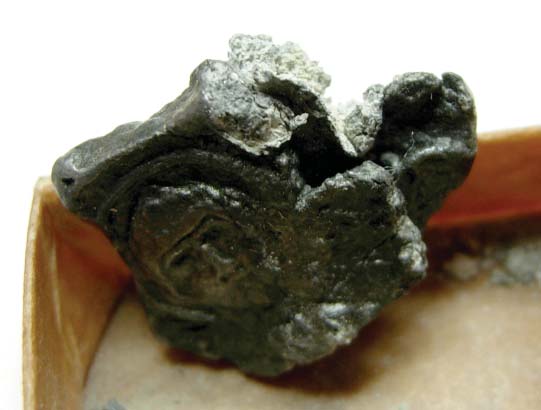ACTIVE CORROSION OF MUSEUM OBJECTS MADE OF LEAD
DOI:
https://doi.org/10.24852/2587-6112.2021.6.235.241Keywords:
archaeological lead, museum lead objects, lead corrosion, active corrosion, cerussite, hydrocerussite, metal conservationAbstract
White powdery corrosion deposits on the surface of lead objects are diagnostic signs of active lead corrosion. It has been established that these deposits are corrosive minerals cerussite and hydrocerussite. They appear on lead artifacts during storage and display, even on objects after conservation treatment. It is known that active corrosion on lead develops in acetic acid vapor. However, it has been observed that active corrosion appears in absence of acetic acid vapors in environment. The article discusses various mechanisms of the occurrence and development of active corrosion on lead objects. The given chemical reactions demonstrate that in conditions of high humidity in the presence of oxygen and carbon dioxide, the appearance of white powder formations of cerussite and hydrocerussite on museum lead objects is possible without the involvement of acetic acid.
References
Carradice, I. A., Campbell, S. A. 1994. In Studies in Conservation 39, 100-106.
Chiavari, C., Martini, C., Poli, G., Prandstraller, D. 2004. In Metal 2004: Proceedings of International Conference on Metals Conservation Metal 04, at Canberra, Australia at the National Museum of Australia, 4-8 October 2004. National Museum of Australia Publ. Canberra: A.C.T., 281-293.
Cronyn, J. M. 1990. The Elements of Archaeological Conservation. London: Routledge.
Degrigny, C., and Le Gall, R. 1999. In Studies in Conservation 44, 157-169.
Lane, H. 1979. In The Conservation and Restoration of Metals. Scottish Society for Conservation and Restoration. Edinburgh, 48-58.
MacLeod, I. D., Wozniak, R. 1997. In Metal 95: Proceedings of the International Conference on Metals Conservation, Semur en Auxois, France, September 1995. London: James & James (Science Publisher) Ltd, 118-123.
Niklasson, A., Johansson, L-G., Svensson, J-E. 2004. In Metal 2004: Proceedings of International Conference on Metals Conservation Metal 04, at Canberra, Australia at the National Museum of Australia, 4-8 October 2004./National Museum of Australia Publ. Canberra: A.C.T., 273-280.
Schotte, B., Adriaens, A. 2006. In Studies in conservation 51, 297-304.
Turgoose, S. 1985. In Miles, G. and Pollard, S. (eds). Lead and Tin: Studies in Conservation and Technology. Occasional Paper № 3. London: UKIC, 15-26.
Organ, R. M. 1977. In Brown, B.F., Burnett, H.C., Chase, W.T., Goodway, M., Kruger, J., and Poubaix, M. (eds). Corrosion and Metal Artefacts. Special publication 179. Washington, D.C.: National Bureau of Standards, 107-142.
Информация об авторах:

Downloads
Published
How to Cite
Issue
Section
License
Copyright (c) 2021 Burshneva Svetlana G., Kozlova Marina A.

This work is licensed under a Creative Commons Attribution-NonCommercial 4.0 International License.







